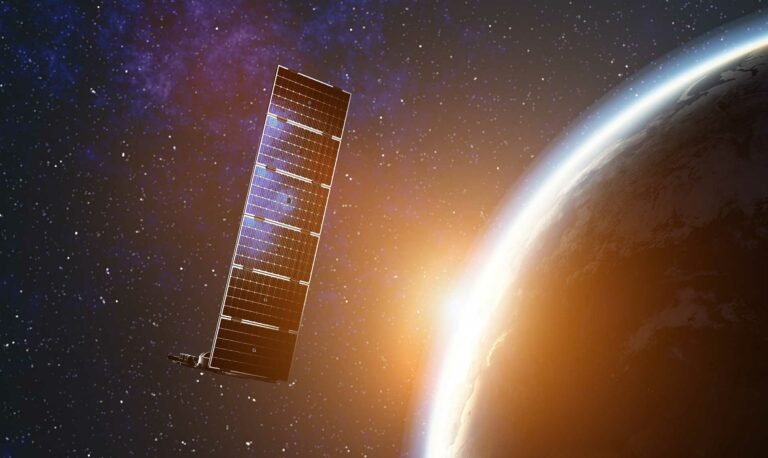Does Starlink work in bad weather?
This is a question that satellite internet users often ask.
After all, nobody wants to lose their signal.
If that happens, try not to worry too much.
You can deal with that problem and solve it when the bad signal-interrupting weather ends.
That way, you will finally return to what you did before everything stopped working.
After reading this article, you can apply fixes or improve signal transmission.
Table of Contents
- How Does Your Internet Satellite Work?
- The Effect Of Weather On Starlink
- Weather Can Affect The Starlink Signal, But How?
- You Can Also Keep The Signal More Stable In Poor Weather
- FAQs
- Summary
How Does Your Internet Satellite Work?

Internet service satellite.
For starters, your home needs to have a satellite dish.
This sends data signals back and forth between other Earth-orbiting satellites.
In the case of Starlink, their satellites orbit 550km above Earth.
The dish transmits those signals through radio frequency bands.
They then beam directly to orbiting satellites. However, buildings and tall trees may otherwise get in the way of transmission.
Weather can also make reaching their destination even harder for these signals.
The Effect Of Weather On Starlink

Bad weather can interrupt your internet signal.
Starlink may lose signal strength due to fog, wind, clouds, rain, snow, or sleet.
Of course, that depends on the weather severity in your region.
| Weather | Effect |
| Fog | If your satellite dish is firmly attached to your home, wind shouldn’t cause it to move. Plus, the phased array antenna helps clear the signal on a windy day. |
| Wind | Normal clouds won’t impact Starlink whatsoever. Instead, storm clouds may distort the signal. That concerns the storm clouds holding in above-average moisture, leading to higher density. After all, that density can easily weaken the signal. |
| Clouds | If your satellite dish is firmly attached to your home, the wind shouldn’t cause it to move. Plus, the phased array antenna helps clear the signal on a windy day. |
| Rain | Drizzle or light rain has zero effect on your Starlink connection. However, you can lose the signal if the rain gets heavier. All of this has to do with the moisture density of the rain clouds. These factors will prevent signal transmission from the dish to the satellite. |
| Snow | Higher snowfall amounts can interfere with signal strength. This depends on moisture density, which will prevent signals from passing through the atmosphere. |
| Sleet | Ice or sleet also keeps signals from reaching the satellites. In turn, that event most likely halts your Starlink internet service. This can quickly resolve itself since Starlink’s satellite dish will dissolve any ice build-up. |
Weather Can Affect The Starlink Signal, But How?

Illustration of a Starlink satellite.
As you can imagine, upload and download speeds will slow as the weather rages.
You will also find it hard to catch any short signal disruptions.
What that means is buffered data helps to keep any shows running while you stream them online.
Playing video games is likely the only time weather will have a noticeable impact.
Even if that happens, Starlink can quickly re-establish the connection.
So you won’t need to wait long — even for minutes — to continue online play.
You Can Also Keep The Signal More Stable In Poor Weather
You can take small, effective approaches to stabilize the signal during poor weather.
Keep Your Satellite Dish Clear

Snowfall
Heavy snowfall may also land on top of your dish. That causes signal interference.
So clear snow, ice, and debris off the satellite dish.
Try out the snowmelt function as well for a more convenient approach.
The Dish Should Always Position Northwards
During a downpour, your Starlink satellite dish might position itself in the wrong direction.
So make sure it points north at all times.
You can do this by stowing, power cycling, then unstowing the dish.
Your Dish Must Have A Clear Path For The Signals
Ensure the dish doesn’t have anything getting in the way of sending a signal.
Poor weather will make this even worse.
You can try mounting your satellite dish on a tall tree or tower for better performance.
FAQs
Can Rain Fade Affect Your Starlink Signal?
Rain fade will cause the signal to bend as it moves through water droplets.
This results in a weaker and distorted signal.
Even then, Starlink performs well in heavy rainfall.
Does Starlink Have Weather-Resistant Qualities?
Yes, it still works in all sorts of weather.
That includes heavy rain, sleet, heat, cold, and high winds.
Do Clouds Block Starlink Signals?
That depends on the type of cloud coverage.
Normal white or grey clouds won’t stop the signals from going through.
Storm clouds, on the other hand, have moisture and rain that disrupts the signal.
Summary
Keep an eye out for strong weather.
The effects make it harder to navigate your internet.
Thankfully, the suggestions in this article will help you get back to normal.
Be sure to follow them accordingly to prevent future issues.

